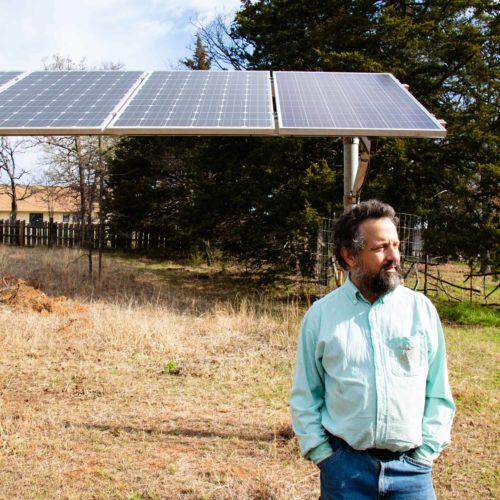This story was published in partnership with The Weather Channel.
Introduction
STILLWATER, OKLA. — Shortly after a crew installed 10 solar panels in the yard near his house, Mike Palmer noticed the dial on his electrical meter start spinning in reverse. He was making more power than he was using.
“On a really sunny day it would just like zoom backwards,” Palmer said. “There’s something immensely satisfying about that.”
Oklahoma, ranked No. 10 nationwide on a common measure of state solar potential, gets plenty of those days. But Palmer’s array is one of only 539 such installations operating there. In fact, 42 states make a greater share of their electricity with solar than Oklahoma does.
It’s reasonable to assume the amount of sun a state gets would tell you a lot about how much solar energy it produces, but the two don’t always have much to do with each other.
In the solar energy race, some of the sunniest states — Louisiana, Kansas and Texas, to name a few — are overshadowed by much dimmer ones, including Vermont, New Jersey and Massachusetts, according to a Center for Public Integrity data analysis.
State policies encouraging or undercutting renewable energy play a big role, experts say.
And how fast states go solar could have long-lasting consequences.
The U.S. is rapidly shifting away from coal, one of the largest sources of greenhouse gas emissions and a top global driver of climate change. But many utilities are turning to natural gas, another fossil fuel, and government analysts expect it will account for more than 40 percent of new electric generation going online from 2021 to 2050.
Natural gas produces fewer greenhouse gas emissions than coal, but it’s composed primarily of methane — a heat-trapping gas many times more potent than carbon dioxide. Thanks to leaks in gas fields and from pipelines, the fuel isn’t as climate-friendly as some producers claim.
These shifts in electricity generation are happening during a crucial time, research suggests. The global consortium of scientists with the United Nations Intergovernmental Panel on Climate Change says the key to avoiding catastrophic consequences of rising global temperatures is a swift move away from fossil fuels toward more renewable and efficient forms of energy.
“Severe climate change impacts … could be avoided by limiting global warming to 1.5 degrees Celsius, but the time to act is rapidly closing,” Caitlin Wiesen with the UN’s Development Program said last fall in Vietnam.
Renewables are projected to be the nation’s fastest-growing source of electricity in the coming years, according to the U.S. Energy Information Administration. Solar-generated electricity alone is expected to grow 32 percent at utilities and 44 percent at residential and small-scale operations by 2020.
But that’s starting from a small base. Less than 2 percent of U.S. electricity was solar powered last year. And the surge in that type of electricity generation is uneven because many states aren’t taking full advantage.

Advances and setbacks
The U.S. was slower to advance solar-generated electricity than other countries, namely Germany and Japan. Solar energy development was boosted in the 1990s and 2000s as states adopted standards that require a certain amount of electricity sold by utilities come from renewable sources. Twenty-nine states have such standards, a common feature among the top solar-producing locales.
Solar energy growth also was fueled by the federal Investment Tax Credit and the expansion of net metering programs, which allow residents to sell and receive credit for excess electricity their small-scale solar installations produce.
That growth of solar energy — particularly small-scale arrays on residential roofs or yards — started hitting new roadblocks in the mid-2000s as the costs of photovoltaic panels dropped, said Leah Stokes, an assistant professor at the University of California, Santa Barbara, who studies energy and environmental politics. As electric customers realized they could save money by making their own power, she said, utilities worried about revenue loss and turned to legislators and regulators for help.
“These battles are being played out in statehouses across the country,” Stokes said.
Those challenges were magnified in 2013 after an analyst prepared a blunt and bleak report for the Edison Electric Institute, which represents the electric utility industry. The report warned that surging consumer interest, political will and technological breakthroughs had the potential to make customer-owned solar so economically successful, it could undermine the business of centralized electricity sales — an existential threat to the utility industry.
“The 2013 report started a conversation about how rate designs need to evolve to reflect new technologies and the costs to deliver power,” Edison Electric Institute spokesperson Brian Reil wrote in an email. “And since 2013, we have seen a dramatic clean energy transformation that has focused on providing customers with the cleaner energy products they want.”
But in those six years, “utilities have not changed their mind” about the business threat posed by customers’ solar generation, Stokes said.

In Florida, which ranks eighth among states in solar energy potential, renewable advocates advanced a 2016 ballot initiative to permit homeowners and businesses to get solar panels without charge from companies that would then sell them the electricity produced.
Utilities scrambled, spending tens of millions of dollars to promote a rival “pro-solar” measure — which high-profile politicians and newspaper editorial boards skewered as deceptive — that could have made it easier for utilities to levy fees on rooftop solar users and slash payouts for extra electricity they generated.
The measure backed by solar supporters didn’t make it on the ballot that year, but the rival utility-backed proposal did — and voters rejected it.
The industry argues that solar customers who receive the full retail rate for electricity they push back onto the grid are not paying for the fixed costs of an expensive and complex power grid built, operated and maintained by utilities.
“The costs of the subsidy are shifted from private solar customers to those customers who do not have, do not want, or in some cases cannot afford … install private solar generation,” Edison Electric Institute wrote in comments on a 2017 U.S. Department of Energy study about the costs and benefits of net metering to utilities.
In 2014, Oklahoma’s then-governor, Republican Mary Fallin, signed a law that cleared a path for utilities to add a surcharge to the bills of new owners of rooftop solar installations and small wind turbines. Utilities pushed for it, arguing that otherwise, these customers wouldn’t pay a fair share of infrastructure and grid costs.
Electric utilities contributed at least $71,000 to Fallin’s political campaigns for lieutenant governor and governor, data from the National Institute on Money in Politics shows.
Oklahoma, like some of the other states that aren’t maximizing their solar resources, is also a major fossil-fuel producer with politics dominated by energy-industry contributions. Oil and gas was the top industry funder of U.S. congressional and Senate races in Oklahoma over the last decade, and Tulsa-based coal producer Alliance Resource Partners was the No. 1 corporate contributor to those races in 2012, 2014 and 2016, according to Center for Responsive Politics data.
Utility customers are compensated for generating electricity in Oklahoma, but not — as in some states — for any electricity pushed back on the grid after their billed costs are zeroed out. Utilities aren’t required to purchase excess generation from customers and credits aren’t carried forward into future billing cycles.
However, solar advocates in Oklahoma were buoyed by a recent attorney general opinion that removed roadblocks for some of the same sorts of third-party ownership contracts sought in Florida.
And though the interests of many electric utilities are aligned, the industry isn’t uniform. Utility companies in other states are moving towards distributed models of electricity that bank on solar energy and battery storage.
Hawaiian Electric Co., which provides power for most of the state’s 1.4 million residents, recently announced plans to build six utility-scale solar projects expected to add nearly 250 megawatts of electricity to three of the state’s most-populated islands.
Those projects include batteries designed to store four hours of energy, which the utility hopes will reduce fossil-fuel use during peak electricity demand. Hawaiian Electric is one of the few utilities that still burn oil to generate electricity, but several years ago the state adopted an aggressive mandate that requires electric utilities to phase out the erratically priced and expensive-to-import fuel source and use 100 percent renewables by 2045.
Renewables accounted for about 27 percent of Hawaiian Electric’s generation in 2018, and nearly half of that amount was generated by solar, said utility spokesperson Peter Rosegg. The island state doesn’t have the land area for large-scale wind farms, he added, so “solar is going to be the big input to the system going forward.”
The company expects to see more than 165,000 privately owned rooftop solar installations by 2030, more than double the number it had in 2017.
Hawaii has top-tier solar energy potential and the highest retail electricity rates in the U.S., big motivators for customers to make their own power and reduce their bills. But even though the state has one of the highest percentages of electricity generated by solar, customers adding panels to their roofs still have faced some hurdles.
Some, for instance, were told by Hawaiian Electric in previous years that they would have to pay for grid upgrades first. Rosegg said the process today is quicker and people are less likely to encounter roadblocks. The utility is deploying new power meters and other systems to accommodate the growth.
“We’re definitely open to more solar on people’s roofs, but it kind of has to come along hand-in-hand with these other efforts to keep the grid stable for everybody,” Rosegg said.

Solar standouts
When Mike Palmer and his wife, Sue McAlister, installed the solar panels outside their home in Oklahoma, the contractor estimated it would take about 20 years for the family to recoup its $22,000 investment.
The solar panels generate about 4,400 kilowatt-hours per year, shave a considerable amount off the couple’s monthly electric bills and give the yard surrounding their rural home some welcome shade.
“Our pony likes to rest under the panels when it’s sunny outside,” Palmer said, laughing.
Palmer and McAlister already are in a small subset of Oklahomans generating electricity from the sun, but the couple has made other upgrades that mean their household is even more of a statistical standout.
Atop their home, the couple installed a rooftop solar thermal system that heats water for household use. Beneath the property lies a geothermal heat pump that uses the constant temperature of the earth to cool the house in the summer and warm it in the winter.
Palmer, a retired Oklahoma State University plant biology professor, said his career influenced the household’s energy choices. He saw firsthand that even small changes to ecosystems have ripple effects.
“The Earth’s very thin veneer of atmosphere and oceans are far more sensitive to human impact than we would like to think,” he said.


Join the conversation
Show Comments